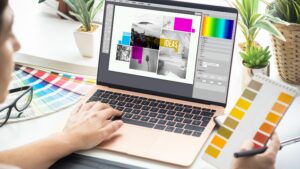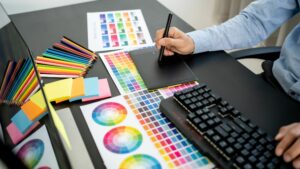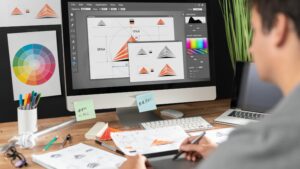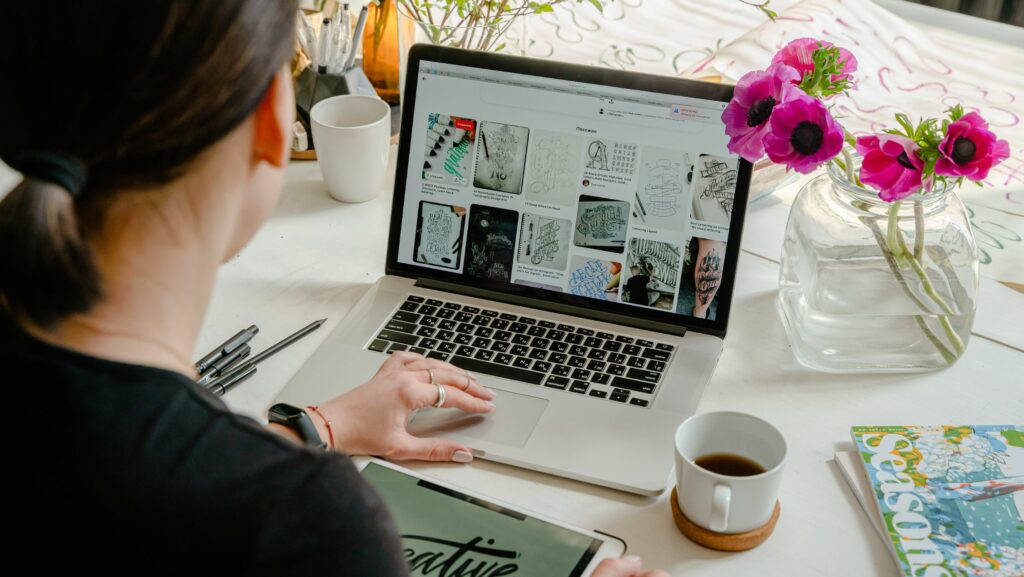In the digital age, the world of work is transforming rapidly. One field that’s thriving in this remote-friendly era is graphic design. With a blend of creativity and tech-savvy skills, graphic designers are finding fruitful opportunities right from their home offices.
From creating compelling visuals for brands to crafting unique website layouts, the scope of home-based graphic design jobs is vast. It’s a fascinating world where art meets technology, and the demand for these skills is soaring.
This article delves into the realm of graphic design jobs from home, exploring the myriad opportunities, the skills required, and how to navigate this exciting career path. Whether you’re an experienced designer or a newbie looking to break into the field, there’s a whole world of remote graphic design jobs waiting for you.
Graphic Design Jobs From Home
 Remote graphic design jobs offer professionals the chance to design visuals without the physical confines of an office. These creative experts produce material like logos, advertisements, website designs, and digital promotional items from the comfort of their homes. It’s important to note that remote/graphic design roles can range from full time, part time to freelance offers, allowing a flexibility tailor-fit to the designer’s lifestyle.
Remote graphic design jobs offer professionals the chance to design visuals without the physical confines of an office. These creative experts produce material like logos, advertisements, website designs, and digital promotional items from the comfort of their homes. It’s important to note that remote/graphic design roles can range from full time, part time to freelance offers, allowing a flexibility tailor-fit to the designer’s lifestyle.
Effective remote graphic design work hinges heavily on a designer’s abilities and the right tools. Top-ranking on the skills index are proficiency in design software such as Adobe Creative Suite, knowledge of color theory, and UX/UI design abilities, along with a keen sense of aesthetics.
However, technical skills alone don’t ensure success in this field. One’s work ethic, time management skills, communication abilities, and capability to work independently can make a significant difference in maintaining productivity while working from home.
Types of Graphic Design Jobs Available Remotely
 Following the exploration of the world of remote graphic design jobs, let’s delve further into the types of graphic design jobs available remotely. These roles not only demand proficiency in design software, color theory, and UX/UI design, but they also require a strong work ethic, impeccable time management, and excellent communication skills.
Following the exploration of the world of remote graphic design jobs, let’s delve further into the types of graphic design jobs available remotely. These roles not only demand proficiency in design software, color theory, and UX/UI design, but they also require a strong work ethic, impeccable time management, and excellent communication skills.
Freelance jobs offer immense flexibility and encourage creatives to take the reins of their careers. In these roles, designers engage in varied projects ranging from logo creation to website design, catering to distinct clients’ needs. For example, a freelance designer might be tasked with creating a series of promotional materials for a marketing campaign one week and redesigning a mobile app’s user interface the next. These jobs often demand their own unique sets of skills and designs tools, predominantly including software like Adobe Creative Suite, Illustrator, and Photoshop.
Freelance designers enjoy the freedom to pick projects that match their skills and interests, often predominantly working from home or any location conducive to their creativity. These roles typically involve regular communication with clients and necessitate a high degree of self-discipline to complete tasks promptly and professionally.
Setting Up Your Home Office for Graphic Design
 Transitioning to home-based design work involves creating an efficient and conducive workspace. It’s essential to equip yourself with the right tools and to design an environment that inspires creativity.
Transitioning to home-based design work involves creating an efficient and conducive workspace. It’s essential to equip yourself with the right tools and to design an environment that inspires creativity.
Central to any graphic design job is equipment and software use. Optimal performance rests on a balance between these two spheres.
Primarily, a high-quality computer is indispensable. Graphic designers often juggle heavy files, making a computer with high processing power and substantial storage space a necessity. In addition, a top-grade monitor that offers high resolution and accurate color representation makes the intricate process of designing easier.
Secondarily, effective software forms the backbone of successful design. Adobe Creative Suite dominates in this aspect, including indispensable software like Adobe Illustrator, Adobe Photoshop, and Adobe InDesign. However, alternatives such as CorelDRAW and GIMP offer a similar standard of operation and may suit some designers.
Other equipment, such as an ergonomic chair and desk, drafting table, quality keyboard and mouse, play vital roles, ensuring comfort and reducing work-related strain. Also, a graphic tablet and stylus can facilitate more natural and precise designing.

